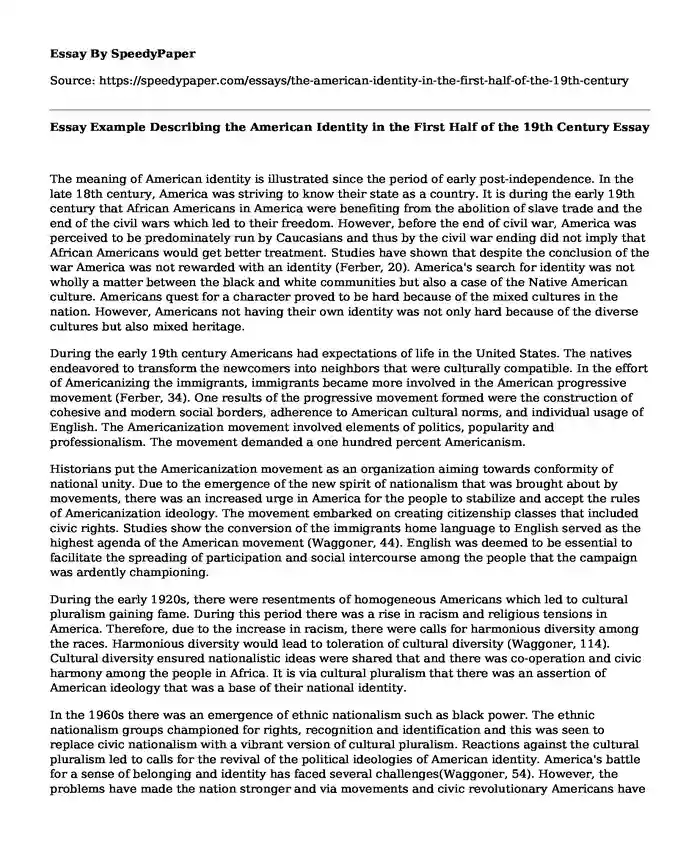
| Type of paper: | Essay |
| Categories: | United States American dream |
| Pages: | 3 |
| Wordcount: | 604 words |
The meaning of American identity is illustrated since the period of early post-independence. In the late 18th century, America was striving to know their state as a country. It is during the early 19th century that African Americans in America were benefiting from the abolition of slave trade and the end of the civil wars which led to their freedom. However, before the end of civil war, America was perceived to be predominately run by Caucasians and thus by the civil war ending did not imply that African Americans would get better treatment. Studies have shown that despite the conclusion of the war America was not rewarded with an identity (Ferber, 20). America's search for identity was not wholly a matter between the black and white communities but also a case of the Native American culture. Americans quest for a character proved to be hard because of the mixed cultures in the nation. However, Americans not having their own identity was not only hard because of the diverse cultures but also mixed heritage.
During the early 19th century Americans had expectations of life in the United States. The natives endeavored to transform the newcomers into neighbors that were culturally compatible. In the effort of Americanizing the immigrants, immigrants became more involved in the American progressive movement (Ferber, 34). One results of the progressive movement formed were the construction of cohesive and modern social borders, adherence to American cultural norms, and individual usage of English. The Americanization movement involved elements of politics, popularity and professionalism. The movement demanded a one hundred percent Americanism.
Historians put the Americanization movement as an organization aiming towards conformity of national unity. Due to the emergence of the new spirit of nationalism that was brought about by movements, there was an increased urge in America for the people to stabilize and accept the rules of Americanization ideology. The movement embarked on creating citizenship classes that included civic rights. Studies show the conversion of the immigrants home language to English served as the highest agenda of the American movement (Waggoner, 44). English was deemed to be essential to facilitate the spreading of participation and social intercourse among the people that the campaign was ardently championing.
During the early 1920s, there were resentments of homogeneous Americans which led to cultural pluralism gaining fame. During this period there was a rise in racism and religious tensions in America. Therefore, due to the increase in racism, there were calls for harmonious diversity among the races. Harmonious diversity would lead to toleration of cultural diversity (Waggoner, 114). Cultural diversity ensured nationalistic ideas were shared that and there was co-operation and civic harmony among the people in Africa. It is via cultural pluralism that there was an assertion of American ideology that was a base of their national identity.
In the 1960s there was an emergence of ethnic nationalism such as black power. The ethnic nationalism groups championed for rights, recognition and identification and this was seen to replace civic nationalism with a vibrant version of cultural pluralism. Reactions against the cultural pluralism led to calls for the revival of the political ideologies of American identity. America's battle for a sense of belonging and identity has faced several challenges(Waggoner, 54). However, the problems have made the nation stronger and via movements and civic revolutionary Americans have been able to attain their status. Surely the American national character stands head high above the tumble and roughness of party politics.
References
Ferber, Linda S. The Hudson River School: Nature and the American Vision. Skira Rizzoli, 2009.
Waggoner, Diane, et al. East of the Mississippi Nineteenth-Century American Landscape Photography. National Gallery of Art, 2017
Cite this page
Essay Example Describing the American Identity in the First Half of the 19th Century. (2022, Apr 20). Retrieved from https://speedypaper.net/essays/the-american-identity-in-the-first-half-of-the-19th-century
Request Removal
If you are the original author of this essay and no longer wish to have it published on the SpeedyPaper website, please click below to request its removal:
- Free Essay about Tax Issues of Withdrawing Assets
- Free Essay Example: Employment Relations
- Free Essay Evaluating the Acquisition of Artforever.com by Neuquen Inc.
- Paper Due Date
- Free Essay Sample. Parental Absence
- My Concern Over the Three Strikes Sentencing Policies
- Paper Example. Literary Analysis of The Lottery
Popular categories




